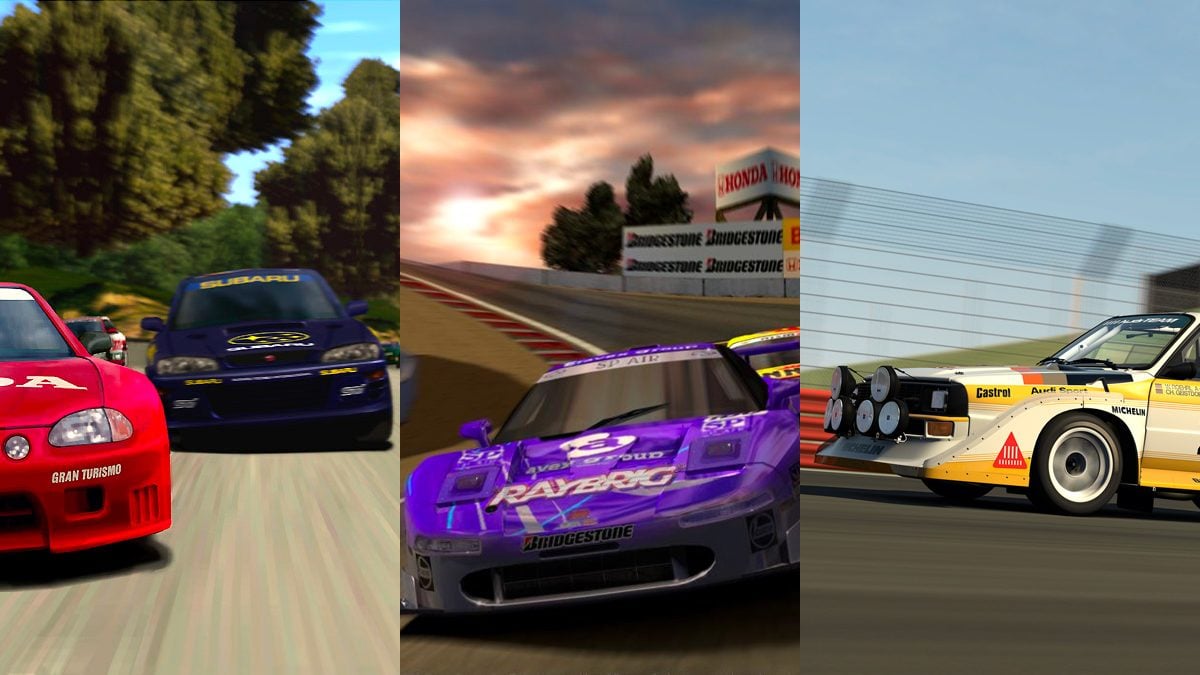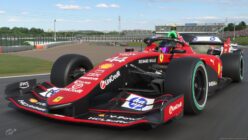What do you call the person that graduated at the bottom of their class in medical school? The answer is deceptively simple: doctor.
By the same token, over the course of the last 20 years, there has to have been a “worst” Gran Turismo. Not wanting to be Negative Nancies, we’re excited to conclude there must also be a “best” installment in the franchise as well. But where do they all fall?
We picked the brains of over a dozen GTPlanet staff members to get to the bottom of this question. To make their jobs (slightly) easier, we’ve ignored the spin-offs and Prologues, as well as the portable Gran Turismo of 2009. Only the numbered mainline titles are up for discussion.
With that out of the way, let’s start with the wooden spoon:
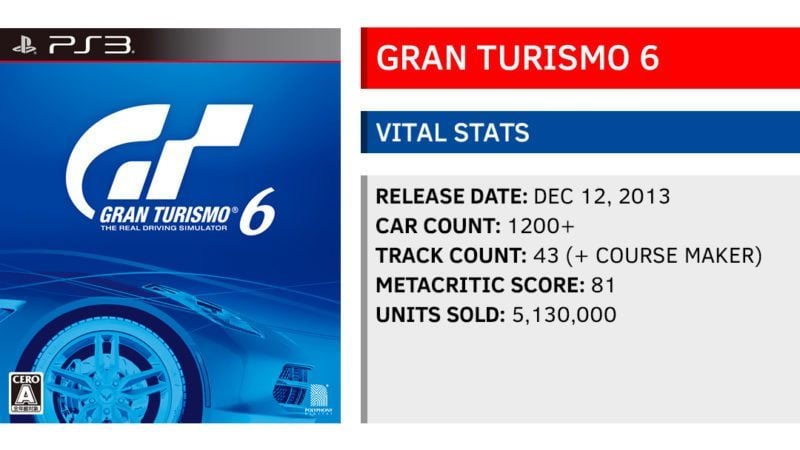
Sixth: Gran Turismo 6
The most recent Gran Turismo release kicks off the list. Occupying the bottom spot on half the lists of those that had played it, Polyphony’s second PS3-era title provided some of the least disagreements amongst the crew.
On paper, GT6 was thoroughly impressive. This was a huge game when it launched in 2013. Over 1200 cars were included at launch, ranging from a pre-war streamliner to designer dreams in the form of the Vision GT project (which isn’t even halfway done yet).
For many, GT6 felt like too small of a jump from GT5. For others, it was the game’s release post-PS4 that did it in. There was little arguing the technical prowess of the game: it undoubtedly pushed the PS3 to — and past — its limits.
The entire track editor saga was awkward to watch unfold: first mentions pegged it as a truly monstrous 100 x 100 km sandbox. Then it was half that. Then 10 x 10. It ended up — over two years later — as even smaller, and an app separate from the game itself, only available on select devices. Luckily, the GTPlanet community quickly figured out ways to make it more accessible.
According to Kazunori Yamauchi, GT Sport is the beginning of a new era for the franchise. Framed as a final chapter of the first age of GT, GT6 makes sense. It once again explored everything about the automobile — it even had a freakin’ moon mission.
If you’re still hoping for a sprawling, car collecting epic after Sport’s autumn release, well, don’t hold your breath. The latest trailer made it clear: Polyphony’s burning that game style to the ground.
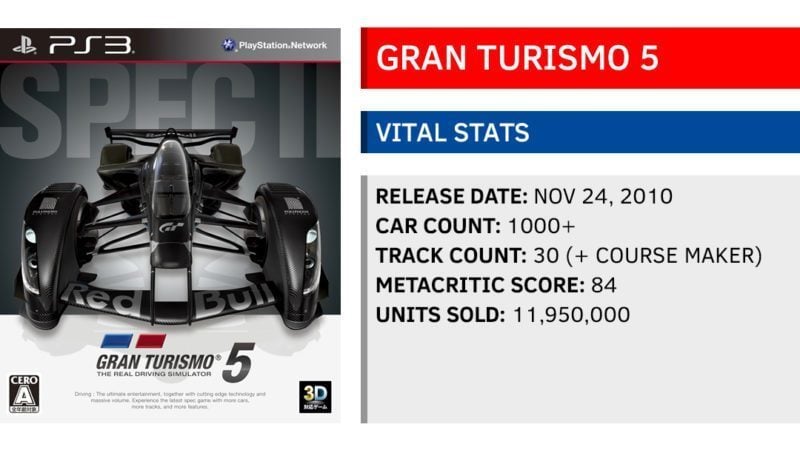
Fifth: Gran Turismo 5
Has there ever been a racing game more hyped than Gran Turismo 5? After years of build-up, the game fans had been waiting for arrived in the final weeks of 2010. It’s hard to believe the first full Gran Turismo of the last generation will be turning seven in a few months.
The problem with hype is that it pushes expectations further and further upwards. Gran Turismo fans were presented with a very different beast than the previous full titles, and even GT5 Prologue. Put simply: it was a GT the likes of which hadn’t been seen before.
“This game changed my life. The infamous delays of this game and the long development time only served to whet my appetite more and more. When it finally released, it lived up to almost all of my expectations. GT5 was special. In more ways than I can express in words.” – Calvin Kirstein
GT5 was a game of peaks and valleys: it boasted over 1000 cars, but the vast majority were carryover assets from the PS2 era. There was a substantial visual damage model… on the handful of WRC cars available. The classic GT career became hyper-linear, with races locked behind an XP system. And don’t get us started on the Used Car Dealership…
Nonetheless, our team found GT5 to be a bigger step for the franchise than GT6, warts and all. It also sold very well, slotting in behind GT3 as the second best-selling game in the franchise.
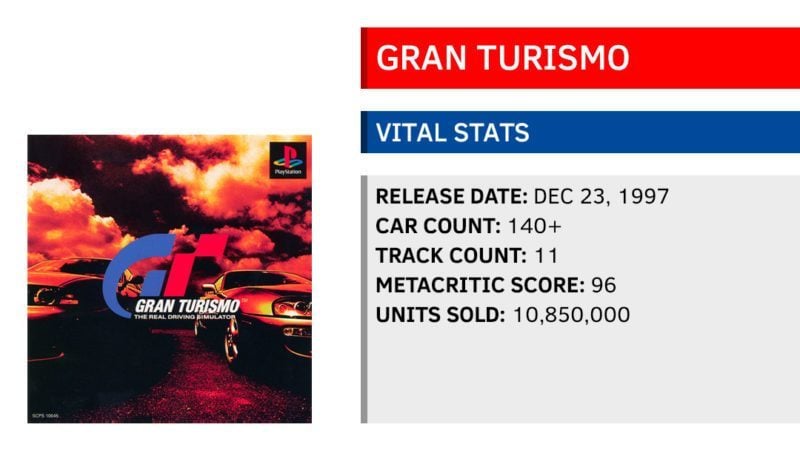
Fourth: Gran Turismo
“The OG which lead Polyphony Digital to king status and the game which set the precedent for many racing games that came after it. You know how the story goes.” – Ameer Zaita
It feels almost cruel to place the first game here. The game that started it all, robbed of even a podium placing? Are we nuts?
Put down those pitchforks. Nobody on the team denies that the first game is the most historically significant. But as an experience, it simply couldn’t keep pace with the stunning games that came after. It’s not that the original Gran Turismo is bad — its just that its younger siblings are better.
Gran Turismo shook up the driving genre on consoles. It came with well over 100 cars, but adopting Polyphony’s current counting policy would see that balloon to almost 300. The game didn’t feature the cars typically reserved for bedroom posters: instead, it offered the cars you saw on the road. Well, so long as you lived in Japan.
Ownership became part of the gaming equation. After saving up enough credits, you could buy a car and tune it your own way. Gran Turismo introduced numerous RPG aspects to the racing world, effectively creating a sub-genre. We still haven’t settled on a proper name for it, though: CarPG? Car-PG? carRPG? Your guess is as good as ours.
A lot has changed in the 20 years since Gran Turismo launched. Kazunori Yamauchi has stated that GT Sport will be the biggest change to the franchise since its inception. Will it be the same sort of turning point the original was all those years ago? We’re looking forward to finding out.
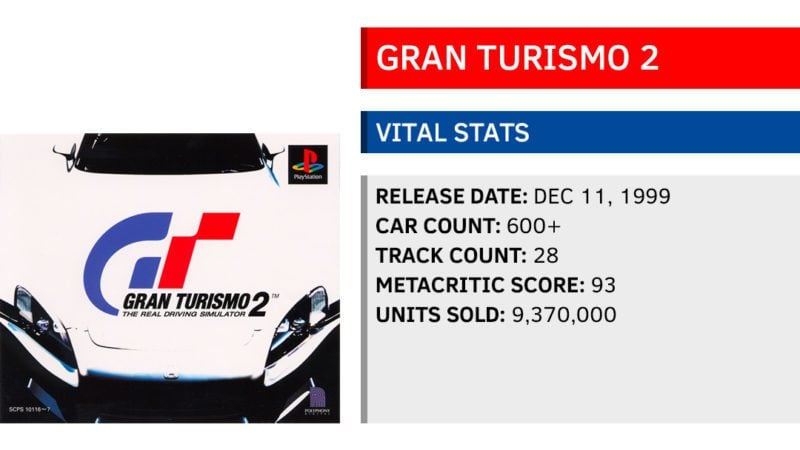
Third: Gran Turismo 2
Gran Turismo 2 earns the lowest podium step in this round-up. How do you follow up on a revolutionary title like the original? You add more of everything.
GT2 took all of the first game’s strengths and amplified them. You liked the huge car list, which already dwarfed everything out there? Polyphony quadrupled it, bringing in all manner of European models and stretching back into the history books. The track list also grew, including new fantasy circuits and the franchise’s first real-world location (Laguna Seca). In addition, Polyphony introduced rally racing.
“The absolute feel this game had was, and still is, fantastic. I feel the nostalgia of not my life, or the game, but the time period in which it was created. It feels like 90s Japan, and where as each game now simply doesn’t have an identity anymore, it’s refreshing.” – Josh Steele
The physics engine received improvements, particularly in the field of aerodynamics. Not only that, players could get to grips with a new damage model.
Gran Turismo 2 managed to grow the series without feeling like it lacked direction. In our minds, it was the definitive PS1-era GT title. If you’re feeling nostalgic, our man Adam recently revisited the game via Bleem on Dreamcast.
With the PS3 and PS1 eras both taken care of, that leaves only one Sony generation left…
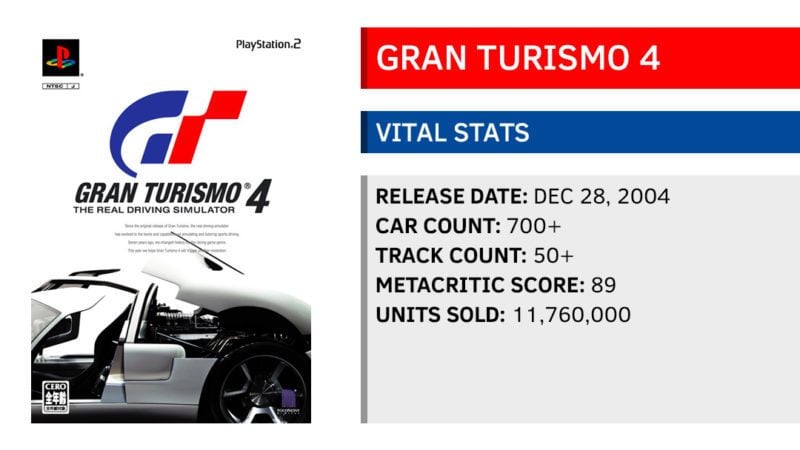
Second: Gran Turismo 4
This was the closest battle of the whole ordeal. There were loud protests. Friendships were ended. Okay, not really. But in the end, with the score sheets tallied up, GT4 lost the top spot by less than a point.
For many of us here at GTPlanet, this was the definitive Gran Turismo game. It represented all that the series stood for: massive, diverse car lists paired with realistic physics and beautiful graphics. GT4 felt very much like GT2 with a serious facelift.
Given a much longer development schedule than previous titles, Polyphony Digital was able to cram everything it had learned into this game. As an ode to the automobile, the game featured the 1886 Benz Patent Motor Wagen, the first of the breed.
“This game defined my taste in cars, and yes, perhaps my enjoyment of it comes from the age I was at the time, and that sense of discovery I’ll never experience again.” – Adam Ismail
Sure, it was still a racing game, but the racing was almost secondary: this was a virtual, interactive encyclopedia on one of mankind’s most world-changing creations.
Photo Mode made almost too much sense given the game’s historical focus. It also turned players into budding photographers, and in a way, free advertisers. It’s no wonder the feature has quickly spread across the genre — and Polyphony is still the best at it.
GT4 featured plenty of idiosyncrasies that would come to define the developer. For some of us, it also marked the beginning of “the bloat,” where features sometimes felt half-baked, and endless permutations of nearly-identical cars filled the ranks.
We couldn’t shake the feeling that Polyphony had too many irons in the fire, something that came to a head in GT6. That’s one accusation that can’t be levelled at the next game, however.
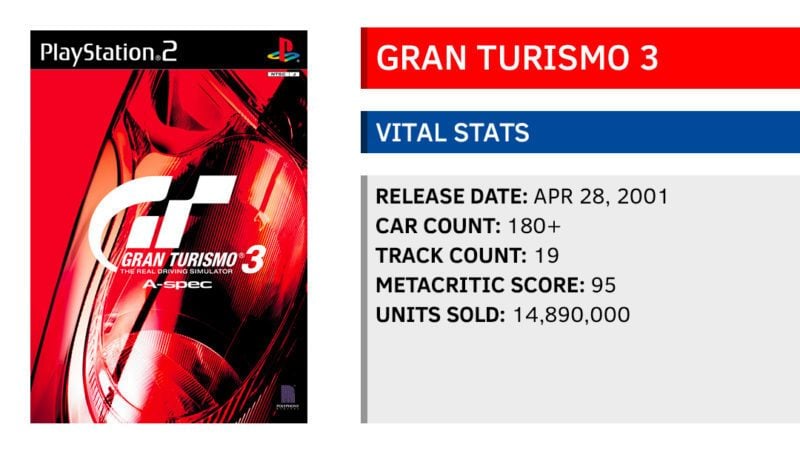
First: Gran Turismo 3
This is the franchise’s Empire Strikes Back. Its Beautiful Dark Twisted Fantasy. Gran Turismo 3 hits the perfect blend of commercial and critical success, with none of the bloat that would come later.
Yes, the car selection was a fraction of GT2’s, but it was all used effectively. There wasn’t a boring, mid-range Saxo or Corsa within the lineup. Instead, we got the Zonda before it showed up anywhere else and effectively replaced the F40 in terms of teenage boy bedroom poster coverage (we mean that in a good way).
This game was fun. It also felt a little rebellious, what with the obvious F1-but-not-F1 cars, the JGTC Lambo, or Yamauchi-san’s personal 996 GT3 being snuck in there. How cool was it to race against various Polyphony employees’ ghosts in Arcade Mode, before realizing the big cheese himself was your target on Complex String?
“GT3 was the right size to be fun and not overwhelming, with enough cars of a wide enough variety and enough tracks that you could experience everything once if you wanted and never felt daunted by your choices.” – Andrew Evans
It also looked fantastic. In 2001, GT3 stood as one of the best-looking games on consoles, period. It was a massive step-change from the graphics of GT2 18 months prior, and to this day remains impressive. Outside of other genre games like Metal Gear Solid 2, we struggle to think of a game that’s aged better.
Gran Turismo 3 felt laser-focused in a way no game in the franchise has since. For that, it stands at the top of the pile.
Conclusion
Is it problematic that a 16 year old game topped our list? Not at all: in many ways, GT Sport certainly seems to follow in its footsteps. Like GT3, Polyphony’s upcoming PS4 racer also boasts a more curated approach compared to its predecessor’s sprawl. The car count is down to a number very similar to GT3’s, and each one has been built for the PS4.
If Polyphony can recapture the magic and apply it to GT Sport, it could very well see another hit on its hands. We’ll find out later this year.
We expect there will be disagreements about the order of this list. What’s your personal ranking look like? Sound off in the comments.
See more articles on GTPlanet Lists.

